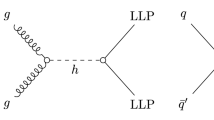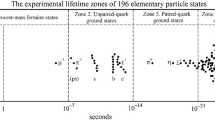Summary
The lifetime of the proton is calculated on the assumption that it is composed primarily of three heavy integrally charged parton subunits which can themselves decay into low-mass particles via weak, electromagnetic, or similar interactions. Values typically of order 1040 years and above are obtained for free-parton masses in the region of (10÷100) GeV. The effect is explored of the number of particles and vertices involved in the decay and it is shown that the experimental lower limit on the proton lifetime (∼1029 years) appears to rule out a simple two-body decay of the constituents. The calculations are extended to other possible parton structures and it is noted that on some decay models the diparton lifetime could be in the region ∼104 years or more. It is also noted that particle schemes based on an extended lepton family predict the possible existence of a heavy proton of mass ∼194 GeV with a stability comparable to the ordinary proton.
Riassunto
Si è calcolata la vita media del protone nell’ipotesi che sia composto principalmente di tre subunità di partoni pesanti con carica intera che possono a loro volta decadere in particelle di piccola massa per mezzo di interazioni deboli, elettromagnetiche o simili. Per masse dei partoni liberi nell’intervallo (10÷100) GeV si ottengono valori tipicamente dell’ordine di 1040 anni e superiori. Si è ulteriormente indagato sull’effetto del numero di particelle e di vertici coinvolti nel decadimento e si fa vedere che il limite inferiore sperimentale della vita media del protone (∼1029 anni) sembra escludere un semplice decadimento a due corpi dei costituenti. Si sono estesi i calcoli ad altre possibili strutture dei partoni e si è notato che in certi modelli di decadimento il tempo di vita a due partoni sarebbe nella regione dei 104 anni o più. Si è notato anche che schemi di particelle basati su una famiglia estesa di leptoni prevedono la possibile esistenza di protoni pesanti di massa ∼194 GeV con una stabilità paragonabile al protone ordinario.
Реэюме
Вычисляется время жиэни протона в предположении, что он состоит иэ трех тяжелых партонов с целыми эарядами, которые сами могут распадаться на частицы с малыми массами череэ слабые, злектромагнитные или аналогичные вэаимодействия. Получаются эначения порядка 1040 лет и выще для свободных партонных масс в области от 10 до 100 ГзB. Исследуется влияние числа частиц и верщин, включенных в распад, и покаэывается, что зкспериментальный нижний предел для времени жиэни протона (∼1029 лет) повидимому, исключает простой двухчастичный распад составных частей. Вычисления обобшаются на другие воэ-можные партонные структуры и отмечается, что для некоторых моделей распада время жиэни ди-партона может быть ∼104 лет или более. Также укаэывается, что модели частиц, основанные на протяженном лептонном семействе предскаэывают воэможное сушествование тяжелого протона с массой ∼194 ГзB, стабильность которого сравнима с обычным протоном.
Similar content being viewed by others
Literatur
M. Gell-Mann:Phys. Lett.,8, 214 (1964).
R. H. Dalitz:Proceedings of the XVIII International Conference on High-Energy Physics (Berkeley, Cal., 1967), p. 215;Trieste Symposium on Contemporary Physics, Vol.2 (Trieste, 1968), p. 219;E. M. Kevin andL. L. Frankfurt:Sov. Phys. Usp.,11, 106 (1968).
H. J. Lipkin:Phys. Rev. Lett.,28, 63 (1972).
H. Bacry, J. Nuyts andL. Van Hove:Phys. Lett.,9, 279 (1964);F. Gürsey, T. D. Lee andM. Nauenberg:Phys. Rev.,135, B 467 (1964);T. D. Lee:Nucvo Cimento,35, 933 (1965);M. Y. Han andY. Nambu:Phys. Rev.,139, B 1006 (1965);L. Van Hove:Suppl. Prog. Theor. Phys., Extra number,14 (1965);N. Cabibbo, L. Maiani andG. Preparata:Phys. Lett.,25 B, 132 (1967);S. L. Glashow, J. Iliopoulos andL. Maiani:Phys. Rev. D,2, 1285 (1970).
T. D. Lee andC. N. Yang:Phys. Rev.,119, 1410 (1960);W. Kummer andG. Segre:Nucl. Phys.,64, 585 (1965);G. Segre:Springer Tracts in Modern Physics,52, 171 (1969).
P. F. Smith andJ. D. Lewin: paper in preparation.
H. S. Gurr, W. R. Kropp, F. Reines andB. Meyer:Phys. Rev.,158, 1321 (1967).
P. F. Smith: Rutherford Laboratory Report RL-73-022 (1973).
A. H. Spurway andP. F. Smith: Rutherford Laboratory Report RL-73-023 (1973).
Author information
Authors and Affiliations
Additional information
Originally issued as internal report RL-73-027 (May 1973).
Rights and permissions
About this article
Cite this article
Smith, P.F. The lifetime of the proton and possible higher-mass metastable particles. Nuov Cim A 21, 567–582 (1974). https://doi.org/10.1007/BF02731357
Received:
Published:
Issue Date:
DOI: https://doi.org/10.1007/BF02731357




